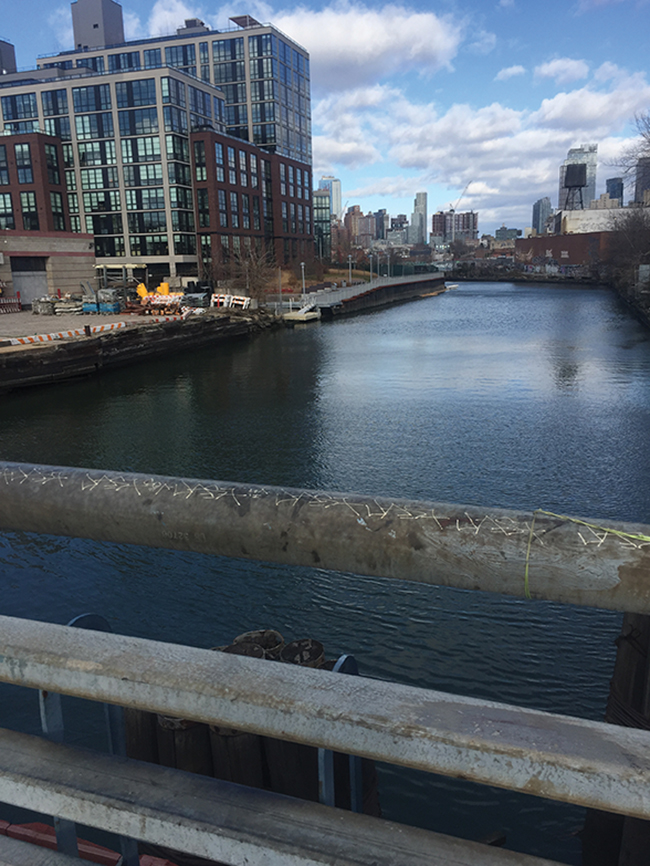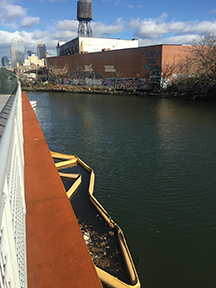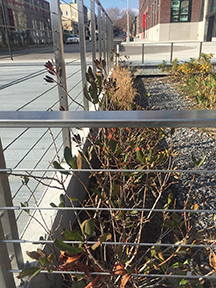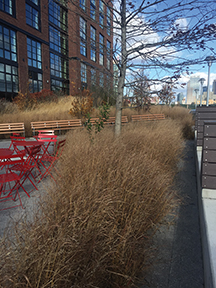The Gowanus Canal Sponge Park™ opened in the fall of 2016. Facing the Canal at the end of 2nd street, the park was designed by DLANDstudio Architecture + Landscape Architecture to clean up the Canal’s notoriously polluted waters. I spoke with Susannah C. Drake, DLANDstudio’s founding principal, who—as a registered architect, landscape architect, and an adjunct professor at the Harvard Graduate School of Design—offers a unique perspective on the topic of green infrastructure and the design challenges that are unique to New York City.

How does the Gowanus Canal Sponge Park™ work?
When we came up with the idea, I didn’t want to go into a neighborhood and say, I’m putting a wetland in your backyard. That wasn’t going to fly, nor do you want to have a true swamp in your backyard. But we do want a landscape that can absorb more surface water runoff, to prevent it from going into your cellar, creating puddles on the street, taking all of the detritus from the street and putting it into our water bodies, and killing wildlife. We wanted to create a landscape to absorb that water. So the term “Sponge Park™” refers to an absorbent landscape. We designed it as a park space, a garden with very absorbent soils that will take all of that water and help make it available to the plants, which will evapotranspirate the moisture and keep it out of the waterway and your cellar.

It seems like this design could be replicated in a lot of different street-ends throughout the city.
Right. When we did the original master plan, working with the Gowanus Canal Conservancy, we designed a system for all of the areas around the Gowanus. We got a grant from the New York State Council on the Arts (NYSCA) to do this initial planning work, and we tried to find every available absorbent surface. We discovered there was this setback that city planning was putting into law where you would have a 40-foot setback from the waterfront plus a 10-foot supplemental walkway. Initially, we thought, this is great. We have all of that landscape available to make Sponge Park™’s. But one thing that differentiates the Gowanus Canal and other industrial canals from a waterfront like Battery Park City is that they’re industrial landscapes which tend to have buildings abutting the waterfront, so you can’t have that continuous walkway or open space. We saw that as a potential opportunity to thread the green infrastructure, or thread the enriched landscape, back into the community. One of the first places we saw an opportunity to do this was at the street-ends, where the land was available and there were no buildings. And so we created this prototypical Sponge Park™ street-end that could be replicated. We’ve done some GIS (Geographic Information System) analysis of other street-ends around the city and found there were a couple of hundred places where this same design could be implemented. The Department of Transportation is really excited about that and they were looking at how much it’d cost to implement it on a broader scale. We’ve been calculating how much water it will actually manage and it manages millions of gallons of water per year. So it could have a very meaningful impact.
DLANDstudio’s fundraising process struck me as unique. Is it unusual for an architecture studio to be working with government agencies and non-profits?
[pullquote]One thing that was so magical about working in Gowanus, that I really appreciated over the last 10 years, was that there were so many different voices and people who really cared about their neighborhood. [/pullquote]We created a completely different paradigm of practice, where we basically look for things that are broken in the city. Sometimes those discoveries happen because of discussions with non-profits who tell us, Hey, there’s an issue in our community and we want to figure out some solutions. Sometimes it’s just from running or biking around the city and seeing something that seems like a design opportunity. But we look for those opportunities and relationships. Then we find sources of funding to first develop some of the planning work and then ultimately fund some of the design development and construction drawings, and then we’ve raised money for for the construction. It’s completely different than a normal procurement process. It’s been fruitful and it was particularly fruitful for my firm because I had been practicing for about 15 years before I started my practice, but my practice was seen as that of a young woman-owned business. The work I do is in the infrastructure space, which tends to be controlled by massive engineering firms, and architecture firms started to find landscape architecture and infrastructure interesting as well. So the competition is quite fierce from huge firms that have been around for a long time and have a lot of built work. But I felt I had a different, important voice to communicate, and that I had the experience to do the work. It wasn’t like I was naive to what it takes to do public work. So I came up with this method of applying for grants from environmental organizations and getting significant amounts of money to build these prototypical green infrastructure systems. So we did the Sponge Park™ and we also did one that we call HOLDS in Flushing Meadows Park. These are ideas, they’re experiments, prototypes that will need to be adjusted as we move forward and think about broader implementation. The point is to use the grant money to enable innovation that can’t happen through a normal procurement process. But it’s completely different. It’s a wacky paradigm. Nobody does this. Nobody did this. Now it’s so funny because the big architecture firms who would get the jobs anyway are all starting little non-profit arms, which is frustrating.
Is this procurement process trickier, or more bureaucratic, than the conventional method?
Every public project is filled with bureaucracy. I have to say the Department of Environmental Protection (DEP) was very patient with me although we drove each other crazy for a while. But they were patient. What was really exciting was that there was an overall vision for creating green infrastructure supported by the Bloomberg administration and the DEP during that administration, that has carried forward into the de Blasio administration. There’s a recognition of the need for these kinds of new strategies that enabled a willingness to experiment. So that was good, but it was tricky because these government entities aren’t set up to receive big grants of money from a random private firm and then give it back to that firm. That’s a tricky thing. It’s hard to figure out how to make that work through a public process. But meanwhile I did all the work to get the grants. I wrote the grant proposals and did all of that on my own dime. So in a way I’m providing great benefit to the city by doing this. It’s not like we’ve made any money doing the project. It’s been all about the research and development of an idea.
Do you think that procurement process encourages more input from stakeholders, the individuals who are actually affected by these designs?
Yes. I did some work up in the Bronx with the Bronx Council for Environmental Quality, and it was pretty great in terms of engaging kids and the community in the development of one of these innovative structures. I think the kids really learned a lot. City agencies can do a lot of really good work. We shouldn’t necessarily try to subvert everything they do because there is a very beneficial public process that can make great parks and playgrounds and make things happen. But to the degree that you can use these kinds of systems to augment initiatives that are happening, like the vision of the city, I think it’s really great. Or if a community group has a vision, as a designer if I can help them realize that vision, it’s really rewarding for me, and for a lot of other designers who care about the communities in which they live. It’s a pretty great method for giving grassroots communities power to implement something, but we do have to remember we also have city council operating on behalf of the public to make things happen. But if you can combine the work of that community group with the work of city council, then you can get something really exciting going because you have more power. So using it as leverage is really the most valuable situation.
I love the idea of THE BQ GREEN project, which hopes to unite the neighborhoods that were divided by the Brooklyn Queens Expressway (BQE). Was there a similar process for that idea?
[pullquote] I’d like to see more women leading firms. There are some very talented women out there leading architecture firms and landscape architecture firms. [/pullquote]I have to give a lot of credit to the New York State Council on the Arts. When I started my firm I applied for a grant from NYSCA to look at capping the BQE over in Cobble Hill and Carroll Gardens, which is pretty close to my office. I developed this vision for making a new park space there, which attracted the attention of city councilwoman Diana Reyna. She invited me to participate in an RFQ (Request for Qualifications) for looking at her neighbourhood and potentially doing something over there. Her neighborhood, Southside Williamsburg, is where BQ GREEN ended up getting developed. We won a competitive bid against some really talented architects and developed that idea. It was really the result of a very involved community process, with a lot of meetings with different stakeholders and groups that didn’t necessarily always want to show up at the same meetings, so we had to have separate meetings for different constituents. We also just went out to the playground and talked to people because we weren’t getting enough voices. So we started talking to people on the street, at church, and at school drop off and pick up. We got a lot of input and found that the community really wanted active recreation space. They had playgrounds for little kids, but they didn’t have space that would keep middle school age kids active and occupied. That was important because the neighborhood has a lot of gang violence. Diana Reyna told a very poignant story about being in the playground as a little kid and hiding behind a water fountain just to avoid being caught in the crossfire between two competing gangs who were having a shootout. So that stuck in the back of our mind. We thought, let’s get the kids out on a sports field instead, really unite the neighborhood, and eliminate, or start to blur the territorial boundaries between two competing neighborhoods, or two different constituencies. I feel like that project has a lot of great potential benefits. Along with Diana Reyna, El Puente, Los Sures, St. Nick’s Alliance, and the Open Space Alliance, we’ve all been trying to make it happen, without necessarily selling out the neighborhood to real estate development interests. So we’re trying to get the city to do it just because it’s the right thing to do. And that’s a really hard lift. But the Borough President has put I think two million dollars into the potential development of it and Diana Reyna has been working tirelessly to try to make it happen, and so has the Open Space Alliance of North Brooklyn. So they’re really pushing to try to make it happen now as well. It’s funny because it’s getting out there and it’s becoming something that feels real. That’s an exciting thing to have something that started as this planning study and vision really driven by the community start to become something that people feel is inevitable.

Your studio really emphasizes interdisciplinary design. Why do you think interdisciplinary design is something to advocate for?
I studied architecture and landscape architecture at Harvard and I got registered in both, and I’ve always wanted to have an interdisciplinary practice. I hire people that have really varied expertise because I feel that it makes a rich environment for the development of design work. You know you can have just smart people coming together and bringing their expertise if you have people who have experience in, say biology or engineering, or we had one woman who was an astronomer, another woman with a background in religion. I had a sculptor bringing their expertise to the design. These people make it so much richer, more interesting. And so I’ve always really focused on maintaining that interdisciplinary atmosphere in the office and trying to do projects that really bridge the disciplines. And that’s a challenge. It’s not something that is really fully understood. There’s always a desire to have these these teams that represent a lot of different disciplines, but having an all-in-one office is very fluid and valuable.
Are sustainable architecture and design becoming more common, either in New York City or generally?
Definitely. It’s much more prevalent. A lot of the ideas that I’m able to make happen are things that people were talking about in the early ‘70s, when I was a little girl. It comes out of the environmental movement. But I think part of the reason those environmental initiatives didn’t take hold in a meaningful way in cities up until now is that there wasn’t an integration of the natural system and the urban system in a way that really could work. So I think there’s a greater understanding of the need for the integration of a greater level of formality—and by that I mean formmaking—with the the function of an ecological system, a greater hybridity between the engineering and the ecological and the architectural to make something really beautiful. When I say “beautiful,” I know that wetlands are beautiful in a particular context. But I think it’s important to understand the civic nature of cities and to have an expression that is a bit stronger or more formal.
What can a reader or average person do to encourage that sustainability, and that integration?
A great book just came out called Nature and Cities: The Ecological Imperative in Urban Design and Planning, published by the Lincoln Land Institute. It has all the top landscape architects represented talking about their approaches to nature and cities. So I would say that’s a perfect primer. The chapter I wrote is excerpted in the magazine Land Lines. It’s a good read. Not to put in a shameless plug for the book, but it’d be a really good primer.
How would you describe the status of women in your industry?
Do you think things are changing right now? I’d like to see more women leading firms. There are some very talented women out there leading architecture firms and landscape architecture firms, in particular. Andrea Cochran is an amazing role model as well as Gustafson Guthrie Nichol, though at GGN, they don’t like to describe themselves as being a woman-owned business. They just say, we are designers who happen to be women. It’s kind of a macho profession. I think the only way we’re going to advance is if more of us decide to take the initiative and start our practices and really take on these leadership positions. Part of that is how you create your own identity. You have to choose to be a leader. If you choose to be a leader you have to really follow up on that, and it’s a lot of work. There’s a lot of nuance. I have a number of friends who are partners in large firms. They have an interesting perspective because they’ve said they never really felt any issue about being a woman, until they made partner. Then they felt like they were treated differently, like they were only able to get to a certain level within the upper partnership ranks. I try not to dwell on it too much, but I am aware of the issues. I’m always aware when I get interrupted more than my male colleagues. I’m aware when I hire somebody who has less experience than I do who is male, and people think they’re the boss. It’s frustrating, but I just deal with it.
Has teaching influenced your work, or do you think of them as separate spheres?
[pullquote]I’m a little bit concerned that as the development pressures push into Gowanus, the amount of open space won’t necessarily be maintained and there might be a loss of that (INDIVIDUAL) expression. [/pullquote]It definitely influences the work. I love teaching and influencing the next generation, and I like bringing people from my academic world into the practice. I’ve had a number of my students come and work with me. It’s been great to watch them grow and develop the ideas that started to germinate within the academy, and then came to fruition through our practice. A number of those people have actually gone on to become teachers themselves, which is is both great and challenging because you don’t want to lose good people. At the same time I want to see people grow. So I’ve really enjoyed it, and I feel I get a lot of ideas from teaching and also, frankly, from traveling to different cities, because I’ve been an adjunct in a lot of different places. I’ve seen a lot of different things which has been helpful.
Are there things you’ve seen in other cities that you’d bring to New York if you could?
I don’t know. New York is so big that it’s really hard to think about implementing some things that work in smaller cities here. I find it remarkable when planners look to a city of 200,000 people and start to apply a system, that would work there, to New York City. To a certain degree, some of those systems work, but sometimes they just can’t because of the scale and population density. It’s a tough environment for plants, and for bicyclists. There’s a need for design here that really understands the scale of operations and that the systems in the city need to keep moving in order to make this place vital. It’s tricky because there are a lot of beautiful things that I see in smaller cities that just wouldn’t work here.
You said in an interview that landscape architecture is always shifting whereas with architecture, you finish a building and it’s finalized, and that you like moving between those different modes.
It’s satisfying to build something and then have it be complete when you’ve finished building it. Whereas with landscape architecture, you’re seeding change. It’s like if you’re having a baby and you need to raise it to be an adult. That’s what being a landscape architect is like. There are a lot of things that can go wrong with that baby along the way unless it’s taken care of and nurtured, and educated or tended to. So it’s nice to work in both and be able to to have the satisfaction of creating something where you can achieve a certain level of perfection immediately and recognize that, and then other cases where you’re actually making something for the next generation.

Urban design seems similar to landscape architecture in that it has to shift and respond to change.
The profession of urban design actually grew out of the profession of landscape architecture. Landscape architecture happened first. There was a profession of architecture. Then in the United States, in the late 19th century, the profession of landscape architecture was born with the creation of all of our great parks. There were clearly beautiful landscapes created in Europe and Asia and all over the world, but landscape architecture involves landscapes that were specifically designed for public use. That’s an American idea and an American profession that was established by, among others, Olmsted and Beatrix Farrand, who was the only female founding member of the American Society of Landscape Architects. Landscape architecture as a degree program started at Harvard around the turn of the century. And then urban design as a degree program started of a couple of decades later, maybe even three decades later, at Harvard. So it’s a newer profession, but urban design co-opted a lot of the work that landscape architects do. So they’re related. And there is a program in urban design at the Graduate School of Design at Harvard that is an MAUD program, and you can come into your MAUD program or MLAUD program with either a degree in architecture or a degree in landscape architecture and you get that urban design degree that has a bit of a qualifier of whether it’s landscape or architecture. But all the students are working together.
Is there anything you’d add for people in Park Slope or Gowanus?
One thing that was so magical about working in Gowanus, that I really appreciated over the last 10 years, was that there were so many different voices and people who really cared about their neighborhood. They saw a great opportunity to make open space with a character that reflected the neighborhood and to actually affect the design. So our master planning work was really intended to be very flexible, so that it could provide a framework for individual expression for its ultimate implementation. I’m a little bit concerned that as the development pressures push into Gowanus, the amount of open space won’t necessarily be maintained and there might be a loss of that expression. Part of the expression had to do with craft and people who were making things, and the fact that it was this industrial neighborhood. Maybe that’s a bit of a romantic vision, but it’s an exciting vision. And it’s something that makes you feel like you’re part of that place. And I know cities have to transform and are very organic. I mean my ancestors actually had a farm in Gowanus. There’s a creek that was named after my family that now all goes into a CSO. So there has to be an ability to embrace change. But I just hope with that change, the Gowanus area will be able to maintain its wonderful diversity.
In Drake’s mind, the Gowanus Canal Sponge Park™ and many of the studio’s designs are an “opportunity to thread the green infrastructure, or thread the enriched landscape, back into the community.” One can hope that this kind of thinking takes hold on a broader scale.
